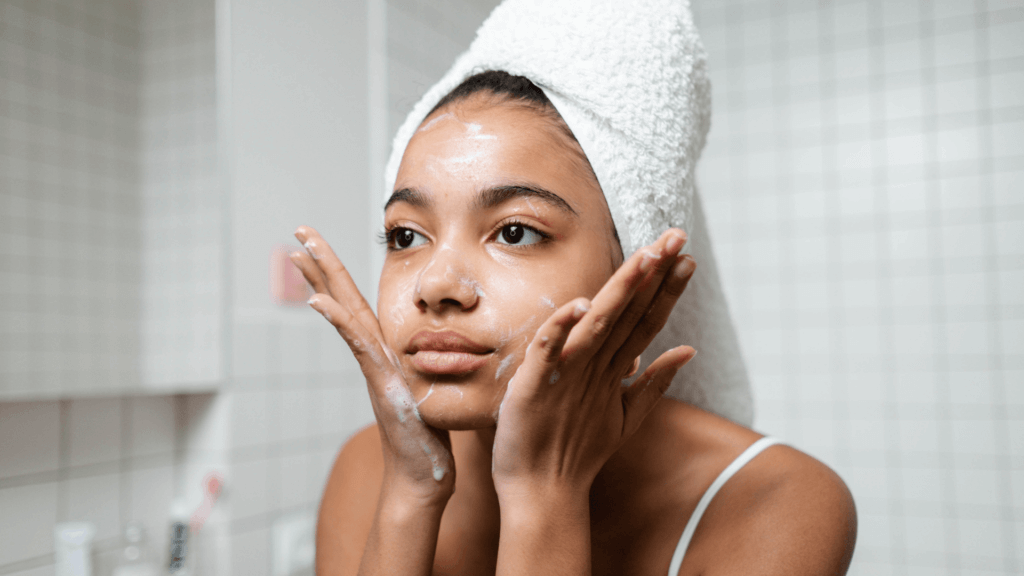Acne is a common skin condition that affects most people at some stage in their lives. There is a misconception that acne only affects teenagers and young adults, but many adults suffer from this condition. Acne can cause pimples, whiteheads, and blackheads to form on the skin, and can also cause the skin to become inflamed, red, and swollen. It can be quite uncomfortable and sore. Acne is usually graded as mild, moderate or severe, with more severe cases being more likely to scar the skin and cause hyperpigmentation. Here, we’re going to explain what the skin condition actually is and what causes it. We’ll also explore different treatment options to help ease symptoms and promote healing.
What Is Acne?
To help us ease symptoms and reduce the frequency of breakouts, it’s helpful to understand how acne develops in the first place. So, let’s start from the beginning. As mentioned above, acne is an inflammatory skin condition triggered by changes in the hair follicles and sebaceous glands, which are located in the middle layer of the skin (aka the dermis). The sebaceous glands have the extremely important role of producing sebum, a natural oil. This oil keeps our skin hydrated and healthy. Think of the outermost layer of the skin as a built-in barrier. It helps to protect us from external factors, like bacteria, chemicals, and UV light. But, to make sure the skin is flexible and strong, it needs to stay hydrated – this is where sebum comes in. However, sometimes our sebaceous glands produce too much sebum and this can lead to acne.
What Causes It?
The pores in the skin are small holes that contain a sebaceous gland and a hair follicle. Acne occurs when excess sebum mixes with dead skin cells to form a plug that blocks the pores, causing the skin to become inflamed. If this plug sits near the surface of the pore, it will bulge outwards to form a whitehead. If it is deeper and the pore is open at the surface of the skin, a blackhead is formed. These plugged follicles provide the ideal environment for bacteria to thrive and so, they can become infected. When this happens, pus-filled pimples, nodules, and cysts can develop.
The sebaceous glands are sensitive to hormonal changes, particularly in those who are prone to acne. During puberty, we experience major hormonal changes, and so we are more likely to develop acne during this time. However, hormonal changes during pregnancy and the menstrual cycle can also trigger acne symptoms and breakouts. Normal hormonal changes are usually the trigger for acne in most cases, but medical conditions, such as polycystic ovarian syndrome (PCOS) and medications (antiepileptic, corticosteroids, contraceptives, and lithium) can also cause acne symptoms.
What Are the Most Common Symptoms?
Now that we know what causes acne, let’s take a look at the most common symptoms. Acne can occur anywhere on the body, it usually appears in areas where there is a high concentration of sebaceous glands, such as the face, chest, upper back, shoulders, and neck. Some of the most common symptoms include:
- Comedones: These are also referred to as whiteheads and blackheads.
- Papules: These are red bumps that become inflamed.
- Pustules: These pimples look a bit like whiteheads but they are surrounded by a red ring and contain pus. Picking, popping and scratching pustules can cause scarring.
- Nodules: These pimples develop deeper in the skin and we often refer to them as “under-the-skin-spots”. They are larger and more solid than pustules, and they can be quite painful.
- Pseudocysts: These are bumps with a small amount of fluid in them, like a cyst. These can also cause scarring.
The presentation and severity of these symptoms can vary greatly from person to person. Of course, we all get pimples from time to time, but that doesn’t necessarily mean that we all have acne. If you get the occasional pimple, you don’t have acne-prone skin. Conversely, someone with acne-prone skin will experience pimples as a symptom of their condition.

How Can I Prevent Acne?
Tackling acne is all about finding balance. Contrary to popular belief, the condition is not caused by unhygienic skin. In fact, scrubbing the skin or using harsh cleansers can actually do more harm than good. The key is to maintain adequate skin hydration whilst trying to reduce excess oil production. It’s important not to dry out the skin completely, as this will encourage the sebaceous glands to produce even more sebum to rehydrate the skin. The following tips may also help reduce the number and severity of breakouts.
Cleansing
Cleansing the skin is extremely important. Use a gentle, pH-neutral cleanser to remove excess oil, make-up, and dead skin cells. Avoid harsh, alcohol-based cleansers as they will dry out the skin, making it feel tight. We recommend always cleansing the skin after working out. This is because sweat can build up on the skin and can lead to clogged pores. However, you may need to turn down your shower temperature. If you’re a fan of very hot showers, you may notice your skin feels tight and dry afterwards. This is because very hot water can remove too much sebum from the skin. Instead, try to opt for a lukewarm temperature.
No Scrubs
Avoid using physical exfoliants like facial scrubs, face wipes, and rough washcloths. Scrubbing acne-prone skin can cause tiny tears in the skin, known as microabrasions. These irritate the skin further and can leave the skin feeling raw, red, and sore, and leave you prone to bacterial infection. Instead, opt for a soft flannel and lukewarm water to gently wipe away cleansers.
Consider adding chemical exfoliants, such as salicylic acid, to your skincare routine. Salicylic acid is a beta-hydroxy acid (BHA) that can help remove excess sebum and dead skin cells to unclog pores. Opt for a lower strength salicylic acid and use it once or twice a week, as part of your nighttime routine, to avoid irritating the skin. When choosing moisturisers and make-up products, look for non-comedogenic or non-acnegenic options. This means that they won’t clog pores.
Reduce Bacteria on The Skin
Try to avoid touching your face with your hands as much as possible. As we know, bacteria can cause the pores to become infected, leading to pimples and pustules. Always wash your hands before applying skin care products to avoid spreading bacteria to the face. We also recommend washing make-up brushes, flannels, towels, and bed linen (especially pillowcases) often. All of these items harbour bacteria and can transfer them onto the skin.
Stay Hydrated
Drink plenty of water. One of the best ways to reduce excess sebum production is to make sure you’re properly hydrated. How do we do this? Make sure you’re getting enough water every day. Invest in a large, reusable water bottle so you can carry it with you and sip throughout the day.
Consider adding hyaluronic acid (HA) into your skincare routine. Hyaluronic acid is a humectant which means that it draws water into the skin, helping to keep it hydrated. HA is incredibly gentle and shouldn’t irritate acne-prone skin.
What Treatment Options Are Available?
First things first – don’t pop that spot! We know it’s tempting but squeezing, touching and picking spots won’t really get rid of the problem. In fact, it could make it worse. Squeezing can push bacteria deeper into the skin, which can lead to more swelling and redness. In addition, picking or popping pimples will leave an open wound on the skin. This is more likely to become infected and it can cause scarring and hyperpigmentation. Instead, pop a pimple patch on and leave the spot to heal. Pimple patches contain hydrocolloid gel, which can help promote healing. This will also help stop you from touching the pimple and irritating it further!
There are many over-the-counter (OTC) products that can help to clear up acne. It can be a case of trial and error to find the right product that works best for you – some may not provide good symptoms control and some can irritate the skin further. OTC acne products come in different strengths, depending on the severity of your symptoms. Benzoyl peroxide-containing products provide very effective acne control for many people. Pharmacists are very knowledgeable about OTC acne treatments and they can help you choose the right product for your needs.
However, if you find that OTC products haven’t helped reduce the severity of symptoms or the frequency of breakouts, you should consult with your doctor. Doctors can prescribe acne treatments, such as gels, creams, and antibiotics that can help.
Acne-prone skin can be quite sensitive and adding new make-up or skincare products to your routine can trigger breakouts. Instead of overhauling your routine in one go, try to add one product at a time, over the course of a few weeks. This will give you a chance to monitor how your skin reacts. To help calm red and inflamed skin, you should opt for soothing and hydrating products.
Give it Time
It is important to be aware that it can 12-18 weeks of using acne treatments before you will notice any significant improvements in your symptoms. This is because the treatments are not managing your current flare, but are affecting the skin cycle to try and prevent future flares in new skin. If you are not seeing improvements at the end of this time, you should speak with your doctor or pharmacist to review your treatment.
How to Request a Prescription for Acne Treatment
Acne can be a tricky skin condition to tackle, but Webdoctor.ie can help. As mentioned above, doctors can prescribe gels, creams and antibiotics that can help. For instance, at Webdoctor.ie, our GPs can provide prescriptions for the following topical treatments, where clinically appropriate:
- Topical treatments (creams & gels)
- Oral tetracycline antibiotics (tablets)
It’s important to note that you should not use oral antibiotics and topical antibiotics (creams/gels) together. This increases resistance and can make the treatment less effective ongoing. The current evidence shows that there are no clinical benefits when these treatments are used together.
To request a prescription for Acne Treatment from Webdoctor.ie simply fill in a brief suitability questionnaire and provide at least two clear photos of your acne. Once your request has been reviewed by one of our Irish-registered GPs, we will send your prescription to an Irish pharmacy of your choice. This is done via secure Healthmail.
If you have any questions about acne or you would like to discuss treatment options in more detail, please don’t hesitate to book an online video consultation with one of our doctors. There, we can talk you through the treatments and answer any questions that you may have.
To stay up to date on your treatments and services, join our online communities on Facebook, Instagram and Twitter. There, you’ll also find lots of medically-reviewed insights on skincare, along with other health and wellness topics.





